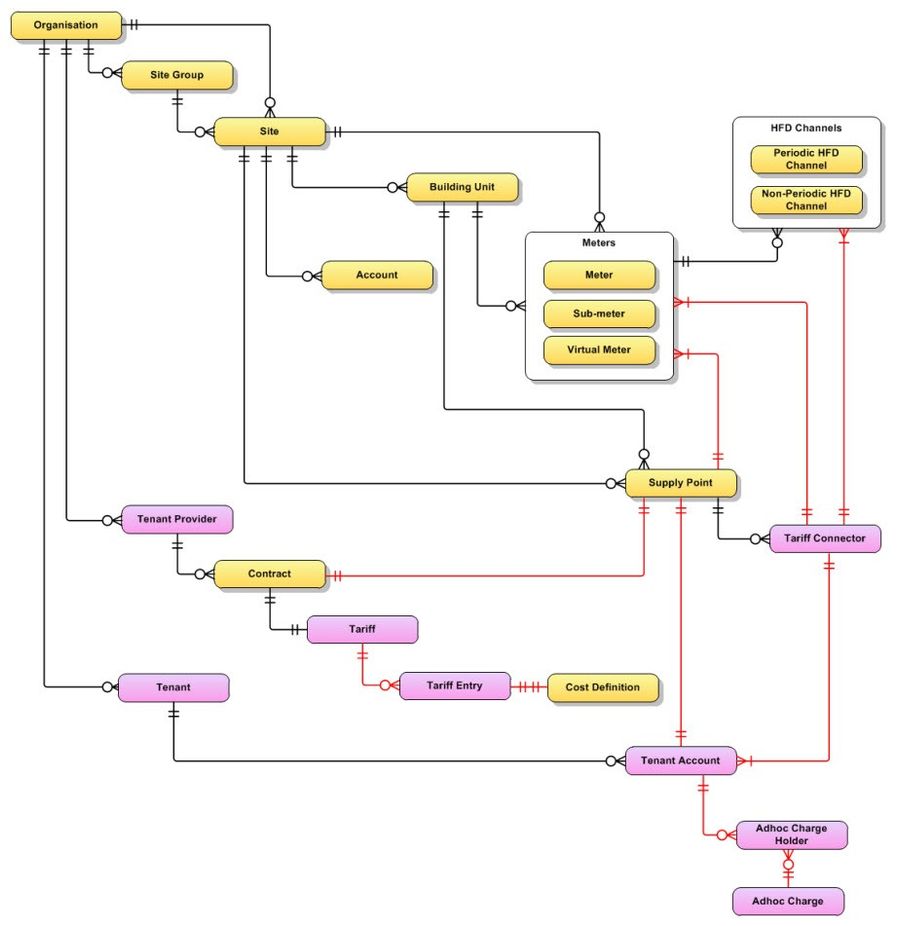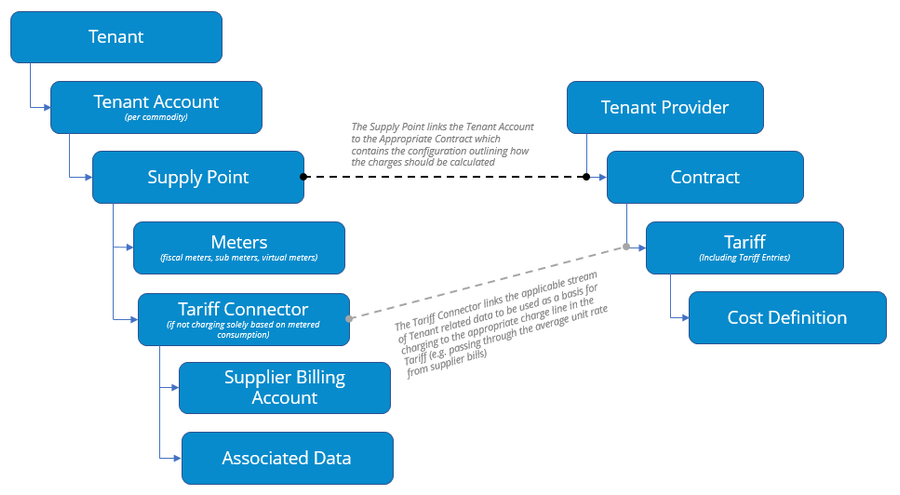Sigma Online User Manual
The Components of Tenant Billing
Glossary
- Click here for a glossary of terms of Sigma Items
- Click here for a glossary of terms of Tenant Billing Items
Overview
The Tenant Billing system uses a number of different components to support the billing of Tenants. In Sigma, these components are known as “Items”. These items ultimately link a Tenant with the appropriate stream of data for recharging with the appropriate Tariff which defines how the charges should be calculated. The hierarchy and relationship between these items is shown in the diagram below:
The diagram below shows a data entity model of all these Items and the relationships that exist between them for Tenant Billing.
Please note:
- Core Sigma Items are shown in yellow (these are items that are fundamental to the use of Sigma, whether it is for M&T purposes, or Tenant Billing purposes only)
- Tenant Billing items are shown in purple.
- Relationships shown with a black line are visible in the Data Selector pane of the Sigma Browser screens.
- Relationships shown with a red line are not visible but are intrinsically related through the other items that are associated with each other.
Tenant Billing Detail
A simplified view of this diagram in terms of the core Tenant Billing items that need to be configured in order to calculate tenant bills is shown below:
A Tenant Provider is effectively the party responsible for billing the Tenants. This holds the company details that would be output on the bill (e.g. VAT Number, Address Details, Contact Details). Multiple Tenant Providers can be created if there is a need to have different parties producing invoices within a single system.
Any number of Contracts can be associated with a Tenant Provider. A Contract is effectively a holder for the configuration details that will be used for calculating charges. A Contract exists for an individual commodity and can be effective dated or set as ‘permanent’ which means it will always be effective.
A Tariff is then linked to the Contract. The Tariff defines the set of charges that will be applied to Tenants linked to the Contract. Each charge is known as a Tariff Entry and contains the configuration and calculation that should be used to generate the charge and the name of the charge that should appear on the bills that are produced.
A Tariff Entry can be linked with a Cost Definition which contains the details of the prices that will be used in the calculation of a specific charge and any specific configuration relating to that price (e.g. Time of Use apportionment of consumption and different rates to use). The Cost Definition can also be effective dated to manage the variation in prices over time (e.g. uplifting the applicable rate every year). It means it can be done once, rather than changing each Tenant Account.
A Tenant is associated with a Tenant Account – this represents the record that the bills for a particular commodity will be associated with.
In order for a Tenant Account to calculate the bills, a Supply Point needs to be created which effectively links the Tenant Account with the Meters and Contract so that the system is able to see which data to use to calculate the charges that are applicable to the Tenant. A Meter could be a fiscal incoming meter, a sub-meter or a virtual meter where the consumption needs calculated (e.g. only a certain proportion need to be inferred from a variety of different meters or sub-meters).A Supply Point is effective dated which means a Tenant Account can be associated with different Contracts for defined periods of time.
The system supports advanced charging mechanisms and different streams of data other than the metered consumption data can be used by the tenant billing engine when calculating the charges. Such examples include information from incoming fiscal supplier bills, or other data associated with a tenant supply such as capacity, floor area, occupancy. To achieve this, items known as Tariff Connectors are used. These are associated with the Supply Point so that the tenant billing engine can source the information as per the configuration in the Tariff Entry, which may point to a data source through the data type that has been configured in the Tariff Connector.
The Sigma Item Hierarchy
A visual representation of where on each of these items sits or can sit within Sigma is provided below:
Tenant Provider
Located under the Organisation
Contract and Tariff
The Contract is located under the Tenant Provider
The Tariff is located under the Contract
Cost Definition
Generally located under the Organisation (but can be at ROOT, Site, Meter, Account etc)
Site Group
Located under the Organisation
Site
Located under the Site Group
Account
Located under the Site. The Account number is prefixed with the Commodity
Meter
Located under the Site. The Meter number is prefixed with the Commodity
Sub Meter
Located under the Site. The Sub Meter number is prefixed with the Commodity
Periodic Channel
Located under the Meter or Sub Meter
Non-Periodic Channel
Located under the Meter or Sub Meter
Virtual Meter
Located under the Site
Tenant
Located under the Organisation
Tenant Account
Located under the Tenant
Supply Point
Located under the Site
Tariff Connector
Located under the Supply Point
Related content
@ Copyright TEAM - Energy Auditing Agency Limited Registered Number 1916768 Website: www.teamenergy.com Telephone: +44 (0)1908 690018
















